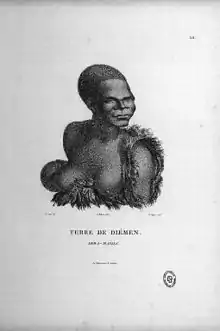
Arra-Maïda, pictured in 1802
Arra-Maïda was an Aboriginal Tasmanian woman who was encountered by members of the French expedition to Australia led by Nicolas Baudin in January 1802 on the shores of Bruny Island.
Arra-Maida, accompanied by a group of women, allowed the French scientists Jérôme Bellefin, François Heirisson and François Péron to make anthropologic observations.[1] Her existence is known through the painting made by Peron, which was published in 1807 in his Voyage de découvertes aux terres australes (A Voyage of Discovery to the Southern Hemisphere, performed by Order of the Emperor Napoleon, During the Years 1801, 1802, 1803, and 1804) together with reports of her behaviour.[2][3]
References
- ↑ First edition, Voyage de découvertes aux terres australes, François Péron, 1807.
- ↑ Bonwick, James. "Chapter 1". The Last of the Tasmanians.
- ↑ Péron, François (1809). A voyage of discovery to the southern hemisphere. London : Richard Phillips.
Further reading
- Hannah, Mark; Macfarlane, Ingereth, eds. (December 2007), Transgressions : critical Australian indigenous histories, ANU E Press and Aboriginal History Incorporated (published 2007), pp. 12–15, ISBN 978-1-921313-43-1
External links
This article is issued from Wikipedia. The text is licensed under Creative Commons - Attribution - Sharealike. Additional terms may apply for the media files.